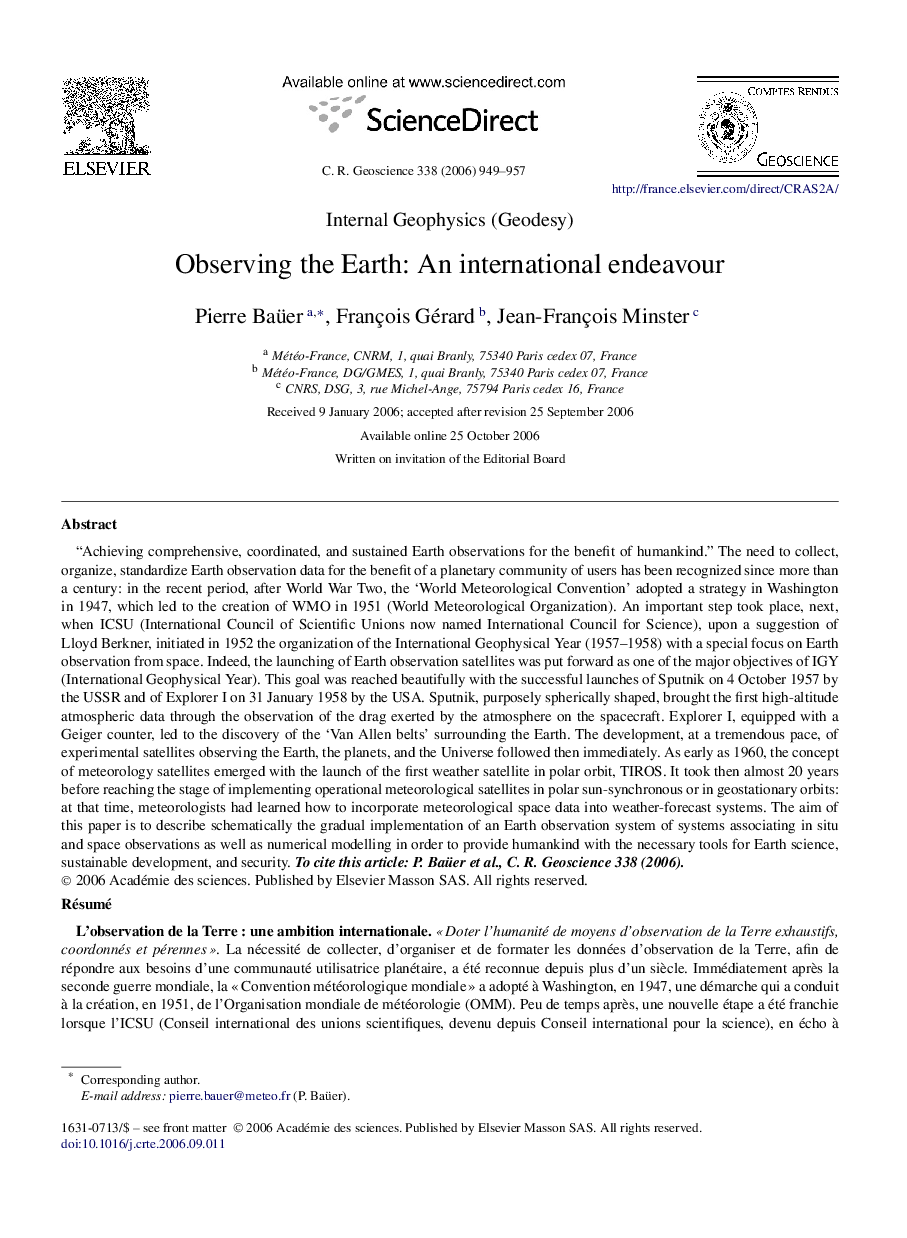| کد مقاله | کد نشریه | سال انتشار | مقاله انگلیسی | نسخه تمام متن |
|---|---|---|---|---|
| 4462938 | 1621580 | 2006 | 9 صفحه PDF | دانلود رایگان |

“Achieving comprehensive, coordinated, and sustained Earth observations for the benefit of humankind.” The need to collect, organize, standardize Earth observation data for the benefit of a planetary community of users has been recognized since more than a century: in the recent period, after World War Two, the ‘World Meteorological Convention’ adopted a strategy in Washington in 1947, which led to the creation of WMO in 1951 (World Meteorological Organization). An important step took place, next, when ICSU (International Council of Scientific Unions now named International Council for Science), upon a suggestion of Lloyd Berkner, initiated in 1952 the organization of the International Geophysical Year (1957–1958) with a special focus on Earth observation from space. Indeed, the launching of Earth observation satellites was put forward as one of the major objectives of IGY (International Geophysical Year). This goal was reached beautifully with the successful launches of Sputnik on 4 October 1957 by the USSR and of Explorer I on 31 January 1958 by the USA. Sputnik, purposely spherically shaped, brought the first high-altitude atmospheric data through the observation of the drag exerted by the atmosphere on the spacecraft. Explorer I, equipped with a Geiger counter, led to the discovery of the ‘Van Allen belts’ surrounding the Earth. The development, at a tremendous pace, of experimental satellites observing the Earth, the planets, and the Universe followed then immediately. As early as 1960, the concept of meteorology satellites emerged with the launch of the first weather satellite in polar orbit, TIROS. It took then almost 20 years before reaching the stage of implementing operational meteorological satellites in polar sun-synchronous or in geostationary orbits: at that time, meteorologists had learned how to incorporate meteorological space data into weather-forecast systems. The aim of this paper is to describe schematically the gradual implementation of an Earth observation system of systems associating in situ and space observations as well as numerical modelling in order to provide humankind with the necessary tools for Earth science, sustainable development, and security. To cite this article: P. Baüer et al., C. R. Geoscience 338 (2006).
Résumé« Doter l'humanité de moyens d'observation de la Terre exhaustifs, coordonnés et pérennes ». La nécessité de collecter, d'organiser et de formater les données d'observation de la Terre, afin de répondre aux besoins d'une communauté utilisatrice planétaire, a été reconnue depuis plus d'un siècle. Immédiatement après la seconde guerre mondiale, la « Convention météorologique mondiale » a adopté à Washington, en 1947, une démarche qui a conduit à la création, en 1951, de l'Organisation mondiale de météorologie (OMM). Peu de temps après, une nouvelle étape a été franchie lorsque l'ICSU (Conseil international des unions scientifiques, devenu depuis Conseil international pour la science), en écho à une suggestion de Lloyd Berkner, a lancé en 1952 l'organisation de l'Année géophysique internationale (1957–1958), avec un accent particulier mis sur l'observation de la Terre depuis l'espace. Le lancement de satellites artificiels dédiés à l'observation de la Terre a effectivement constitué l'un des objectifs majeurs de l'AGI (Année géophysique internationale). Cet objectif fut atteint magistralement, dans la mesure où on vit successivement la mise en orbite, couronnée de succès, de Spoutnik le 4 octobre 1957, pour le compte de l'URSS, et d'Explorer I le 31 janvier 1958, pour celui des États-Unis. Spoutnik, dont la forme sphérique avait été choisie à cet effet, apporta les premières mesures sur la densité atmosphérique de haute altitude, déduites du freinage exercé par l'atmosphère sur le satellite. Explorer I, doté d'un compteur Geiger, permit de son côté de découvrir les ceintures de radiation de « Van Allen ». Le développement, à un rythme considérable, de satellites artificiels expérimentaux d'observation de la Terre, des planètes et de l'Univers s'ensuivit immédiatement. Dès 1960, le concept de satellites météorologiques émergea et se concrétisa avec le lancement, sur une orbite polaire, de TIROS, le premier satellite météorologique. Il fallut ensuite pratiquement 20 ans pour pouvoir disposer de satellites météorologiques opérationnels, placés sur des orbites héliosynchrones ou géostationnaires : les météorologistes avaient, dans l'intervalle, appris à assimiler les données météorologiques spatiales dans les modèles de prévision. L'objectif de cet article est d'esquisser schématiquement la mise en œuvre graduelle d'un « système de systèmes d'observation de la Terre » associant observations in situ et spatiales à la modélisation numérique, afin de fournir à l'humanité les outils nécessaires pour appréhender la science du système Terre et pour aider à la décision en matière de développement durable et en matière de sécurité. Pour citer cet article : P. Baüer et al., C. R. Geoscience 338 (2006).
Journal: Comptes Rendus Geoscience - Volume 338, Issues 14–15, November–December 2006, Pages 949–957